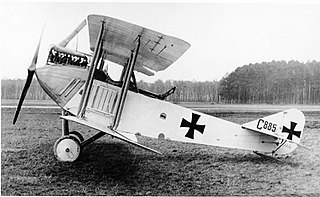
The AEG C.II was a German two-seat biplane reconnaissance aircraft produced in small numbers from October 1915. It was a slightly smaller version of the C.I with better performance, redesigned cockpit for both pilot and observer/bombardier, new rear mounting for a 7.92 mm (.312 in) Parabellum MG14 machine gun, and the ability to carry four 10 kg (22 lb) bombs for light attack duties.

The AEG C.III was a two-seat biplane reconnaissance aircraft, a single prototype of which was built during World War I. The aircraft featured an unusual fuselage design that completely filled the gap between the upper and lower sets of wings, to provide the pilot with improved vision, and to allow the observer a wider field of fire for his 7.92 mm (.312 in) machine gun. The pilot sat to the rear of the observer, who was stationed over the upper wing. This design was not as successful as had been hoped, and the C.III was never entered into service. Despite being heavier than the C.II, its maximum speed increased to 158 km/h (98 mph).
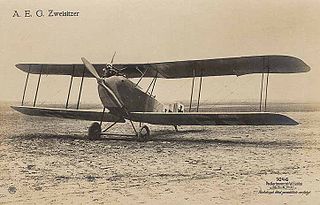
The AEG C.IV was a two-seat biplane reconnaissance aircraft designed and produced by the German aircraft manufacturer Allgemeine Elektrizitäts-Gesellschaft.
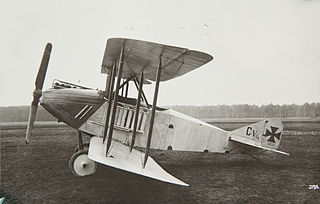
The AEG C.V was a prototype two-seat biplane reconnaissance aircraft of World War I. Designed to use a more powerful engine than previous AEG C-class reconnaissance aircraft, results were disappointing enough that further development was cancelled.
The AEG C.VI was a prototype two-seat biplane reconnaissance aircraft of World War I. It was developed in 1916 from the AEG C.IV, but did not enter production.

The AEG D.I was a biplane fighter of World War I. Three prototypes were ordered, but after the first two were involved in serious crashes, one of which killed flying ace Walter Höhndorf on September 5, 1917, development was cancelled. A triplane version was built as the Dr.I. The second and third prototypes differed little from the first except in detail.
The AEG DJ.I was a highly streamlined biplane ground attack aircraft of late World War I that was undergoing evaluation at the time of the Armistice.

The AEG Dr.I was a triplane fighter of World War I, based on the D.I. Only a single prototype was built and its poor performance meant that no production ensued. The Dr.I was a Dreidecker (triplane) variant of the D.I and had been inspired by a Sopwith Triplane that had been captured intact. A number of proposals for fighters with comparable characteristics were put forward, and AEG's contribution to the program appeared in October 1917. Other than the triple wing it was a D.I, the aircraft had the same fuselage, engine and twin gun armament of its earlier brethren.

The AEG G.I was a three-seat, twin-engined German biplane bomber aircraft of World War I. It was tested and found to be viable for air-fighting in the latter half of 1915 but performed poorly, necessitating the development of the AEG G.II.

The AEG G.II was a German biplane bomber aircraft of World War I developed from the AEG G.I, with more powerful engines. The G.II was typically armed with three 7.92 mm (.312 in) machine guns and 200 kg (440 lb) of bombs. The bomber suffered stability problems, and many G.IIs were fitted with additional vertical tail surfaces on each side of the fin and rudder to improve flight handling characteristics.

The AEG G.III was a German biplane bomber aircraft of World War I developed from the G.II. Like its predecessor, it was only built in small numbers and saw limited operational use, mainly far from the main fronts of the war.

The AEG G.V was a biplane bomber aircraft of World War I, a further refinement of the AEG G.IV. The type saw limited production before the Armistice, and never entered operational service. It featured a 600 kg (1,320 lb) bombload.

The AEG J.I was a German biplane ground attack aircraft designed and produced by the German aircraft manufacturer Allgemeine Elektrizitäts-Gesellschaft. It was a mission-specific derivative of the AEG C.IV reconnaissance aircraft.

The AEG PE was a triplane ground-attack aircraft of World War I, one of the first aircraft designed from the outset for that role. The Idflieg rejected it on the grounds that its poor maneuverability made it too vulnerable to enemy fighters.

The Albatros C.VII was a German military reconnaissance aircraft which saw service during World War I. It was a revised and re-engined development of the Albatros C.V, which had proved disappointing in service.

The Albatros C.X was a German military reconnaissance aircraft that saw service during World War I.
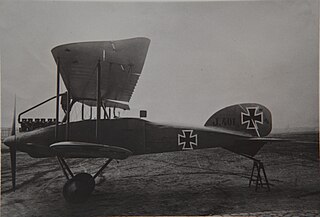
The Albatros J.I was a German armored ground attack airplane of World War I, produced in 1918.
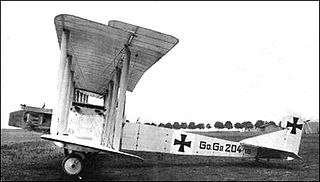
The Gotha G.II series was a heavy bomber used by the Luftstreitkräfte during World War I.
The Halberstadt C.III was a German single-engined reconnaissance biplane of World War I, built by Halberstädter Flugzeugwerke.
The Halberstadt C.VII was a German single-engined reconnaissance biplane of World War I, built by Halberstädter Flugzeugwerke. It was derived from the Halberstadt C.V, with a more powerful supercharged 183 kW (245 hp) Maybach Mb.IV engine.

















